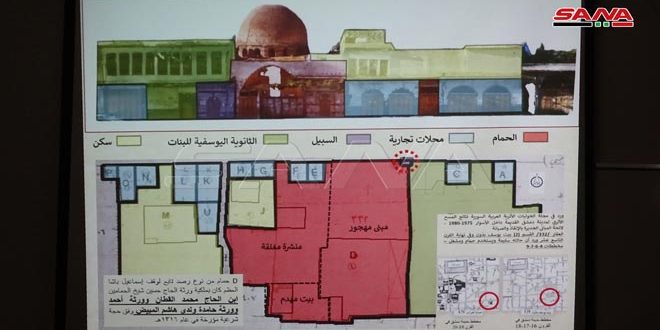Students of the Faculty of Architectural Engineering of Damascus University are working hard to shed light on the unknown archeological sites in Damascus which reflect the diversity and richness of the civilizations that were formed on the land of the oldest continuously inhabited city in the world. The common goal of the students is to document these sites, rehabilitate them and show their hidden beauty through investing in them touristically.
Given Damascus archeological richness, a number of students doing their master degree in the Faculty of Architecture recently presented some studies to revive these historical sites with available capabilities.
A study by engineer Mohammad Qasem highlighted the archeological building of the Police Department near the Interior Ministry headquarters in Damascus. It focused on the history of this building and presented a renovation plan to fix the damage that caused to this building with the passage of time.
The historical noria of Sheikh Mohi El-Din and the surrounding house located in the Al-Nawaeer alley in Al-Salhiya area was also the theme of a study by engineer Hdiyyeh Abdula Razzaq Aqbiq. The study noted the need to rehabilitate and document the noria site and to adopt it as a museum in order to restore life to the noria.
Aqbiq said that what made her conduct such a study is the ancient history of this noria, which was built in the Ayyubid era 800 years ago. She added that she wanted to acquaint the Syrians with a special model of norias found in Damascus and which they don’t know about, since they only know about the norias of Hama province.
On her part, engineer Abeer Mu’az said that her study focused on documenting, renovating and rehabilitating Hammam Al-Safi (Al-Safi public bath) in Al-Shaghour neighborhood. The study stressed the importance of restoring the bath and re-operating it as a public bath with the aim of maintaining the Syrian heritage and introducing the generations to the history of their ancestors.
Engineer Tony Yaziji, Head of the Damascus Antiquities Department, affirmed the importance of the submitted studies as they presented effective solutions for the restoration and rehabilitation of historical places in Damascus. These studies also contribute to documenting archeological building in Damascus, registering the unknown sites and presenting suggestions for the tourist reactivation of these sites, he said.
He stressed the need to benefit from the energy and creative thinking of youths and to support and implement their studies on the ground in order to contribute to the development of the tourism sector and the revitalization of archaeological sites in Syria.
Hamda Mustafa

